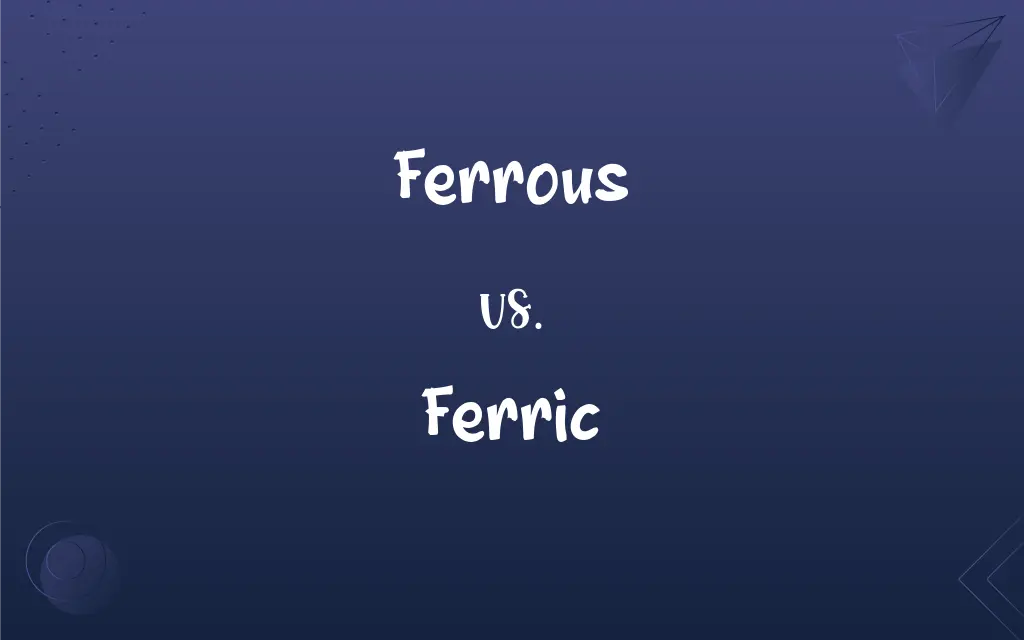Ferrous vs. Ferric: What's the Difference?
Edited by Aimie Carlson || By Harlon Moss || Updated on October 3, 2023
Ferrous denotes iron with a +2 oxidation state, while ferric refers to iron with a +3 oxidation state, affecting their physical properties and chemical reactivity.

Key Differences
Ferrous, chemically symbolized as Fe^2+, represents iron that is in a +2 oxidation state. This term is used frequently to describe various iron compounds (like ferrous oxide or ferrous sulfate) and indicates that the iron ion is missing two electrons, giving it a positive charge. Ferric, contrastingly, is denoted as Fe^3+ and encompasses iron in a +3 oxidation state, signifying it has an absence of three electrons. The defining characteristics of ferric iron compounds, such as ferric chloride or ferric oxide, stem from this particular ionic state.
The differences between ferrous and ferric iron are not merely numerical but also entail distinct physical and chemical properties. For instance, ferrous iron, or Fe^2+, usually forms greenish or pale blue compounds and is capable of acting as a reducing agent. On the other hand, ferric iron, recognized as Fe^3+, commonly forms compounds that are brown or yellowish-brown and demonstrates a propensity to act as an oxidizing agent.
In biological and environmental contexts, the differentiation between ferrous and ferric is paramount. Ferrous iron, due to its lower oxidation state, is generally more soluble in water compared to ferric iron, which implicates it significantly in biological iron metabolism and environmental iron cycling. Ferric iron's limited solubility often results in the precipitation of iron hydroxides in aqueous systems, which can influence environmental conditions and nutrient availability.
Applications and industrial processes differentiate notably between ferrous and ferric compounds owing to their dissimilar reactivity and properties. Ferrous compounds might be utilized in dietary supplements due to their higher solubility, while ferric compounds find uses in water treatment as flocculating agents owing to their ability to precipitate. These utilizations underscore the importance of understanding and utilizing the distinct behaviors of ferrous and ferric iron in various contexts.
Comparison Chart
Oxidation State
+2
+3
ADVERTISEMENT
Electron Loss
2 electrons lost
3 electrons lost
Typical Color
Greenish or pale blue compounds
Brown or yellowish-brown compounds
Solubility
Generally more soluble
Less soluble
Biological Importance
Essential for hemoglobin
Integral for ferritin and hemosiderin
Ferrous and Ferric Definitions
Ferrous
Ferrous compounds typically exhibit pale green or blue colors.
The pale green color of the solution indicated the presence of ferrous ions.
ADVERTISEMENT
Ferric
Ferric ions, or Fe^3+, act as oxidizing agents in chemical reactions.
Ferric iron oxidized the ferrous iron in the solution.
Ferrous
Ferrous ions can act as reducing agents in chemical reactions.
Ferrous iron reduced the permanganate to a colorless compound.
Ferric
Ferric iron's solubility is generally lower than ferrous iron in water.
Ferric hydroxides precipitated out of the solution, causing discoloration.
Ferrous
Ferrous materials can corrode, forming rust in the presence of oxygen.
The ferrous railings, exposed to the elements, eventually rusted.
Ferric
Ferric compounds frequently appear brown or yellowish-brown.
The ferric solutions turned the paper brown, indicating the presence of Fe^3+.
Ferrous
Ferrous refers to iron compounds with an oxidation state of +2.
Ferrous sulfate is often used in iron supplements.
Ferric
Ferric pertains to iron compounds wherein iron possesses a +3 oxidation state.
Ferric chloride is commonly used to flocculate contaminants in wastewater treatment.
Ferrous
Ferrous iron is more soluble in water compared to its ferric counterpart.
Ferrous bicarbonate readily dissolves, contributing to the groundwater's iron content.
Ferric
Ferric ions are integral to various biological functions, including oxygen storage.
Ferric ions in ferritin store iron safely within cells.
Ferrous
Relating to or containing iron, especially with valence 2 or a valence lower than in a corresponding ferric compound.
Ferric
Relating to or containing iron, especially with valence 3 or a valence higher than in a corresponding ferrous compound.
Ferrous
Of or containing iron.
Ferric
Pertaining to, derived from, or containing iron.
Ferrous
(chemistry) Of compounds of iron in which it has a valence or oxidation number of 2.
Ferric
(chemistry) Of compounds of iron in which it has a valence or oxidation number of 3
Ferrous
Pertaining to, or derived from, iron; - especially used of compounds of iron in which the iron has its lower valence of two; as, ferrous sulphate.
Ferric
Pertaining to, derived from, or containing iron. Specifically (Chem.), denoting those compounds in which iron has a higher valence than in the ferrous compounds; as, ferric oxide; ferric acid.
Ferrous
Of or relating to or containing iron
Ferric
Of or relating to or containing iron
FAQs
Can ferrous iron oxidize to ferric iron?
Yes, ferrous iron can oxidize to ferric iron in the presence of an oxidizing agent.
What distinguishes ferric compounds?
Ferric compounds involve iron in a +3 oxidation state (Fe^3+).
Why does ferrous iron corrode?
Ferrous iron corrodes, especially forming rust, due to its reaction with oxygen and water, eventually forming ferric oxides/hydroxides.
Are ferrous and ferric descriptive of specific iron isotopes?
No, ferrous and ferric describe oxidation states, not isotopes, and apply to all isotopes of iron.
Why are ferric compounds usually brown or yellow?
The d-electrons of Fe^3+ ions absorb and reflect light in a way that typically manifests as brown or yellow colors in ferric compounds.
How does the solubility of ferrous and ferric iron differ?
Ferrous iron is generally more soluble in water compared to ferric iron.
Which form of iron is typically involved in rust?
Both ferrous and ferric ions are involved in rust formation, though ferric oxides/hydroxides primarily color rust.
Can ferrous iron be found in hemoglobin?
Yes, ferrous iron is present in hemoglobin, binding oxygen during respiration.
Can ferrous compounds act as oxidizing agents?
Typically, ferrous compounds act as reducing agents due to their lower oxidation state.
How can I differentiate between ferrous and ferric iron in a lab setting?
A colorimetric method or a redox titration can differentiate between ferrous and ferric iron based on their distinct properties.
How does ferric iron interact in biological systems?
Ferric iron can interact with various proteins and is pivotal for electron transport and iron storage in organisms.
What does ferrous mean in chemistry?
Ferrous refers to iron compounds where iron is in a +2 oxidation state (Fe^2+).
Are ferrous and ferric nomenclature applicable to other metals?
No, "ferrous" and "ferric" specifically refer to iron ions in the +2 and +3 oxidation states, respectively.
How do ferrous and ferric ions behave in an aqueous environment?
Ferrous ions are more soluble and can be bioavailable in aqueous environments, while ferric ions often precipitate, affecting nutrient cycling.
Are ferrous and ferric compounds used in industry?
Yes, both ferrous and ferric compounds have diverse industrial applications, like in metallurgy, water treatment, and pigment production.
How can I convert ferrous iron to ferric iron in a chemical reaction?
Oxidizing agents, such as oxygen or hydrogen peroxide, can be used to oxidize ferrous to ferric iron.
Why is ferrous iron often greenish?
Ferrous iron often forms greenish compounds due to the light absorption and reflection properties of Fe^2+ ions.
Is ferric iron used in dietary supplements?
Ferrous iron, being more soluble, is commonly used in dietary supplements, though ferric forms are also utilized.
Does ferric iron play a role in oxygen storage in biology?
Yes, ferric iron is integral in ferritin and hemosiderin, which store iron in biology.
Are ferrous and ferric terms applicable to elemental iron?
No, ferrous and ferric specifically refer to iron ions or compounds, not elemental iron.
About Author
Written by
Harlon MossHarlon is a seasoned quality moderator and accomplished content writer for Difference Wiki. An alumnus of the prestigious University of California, he earned his degree in Computer Science. Leveraging his academic background, Harlon brings a meticulous and informed perspective to his work, ensuring content accuracy and excellence.
Edited by
Aimie CarlsonAimie Carlson, holding a master's degree in English literature, is a fervent English language enthusiast. She lends her writing talents to Difference Wiki, a prominent website that specializes in comparisons, offering readers insightful analyses that both captivate and inform.































































